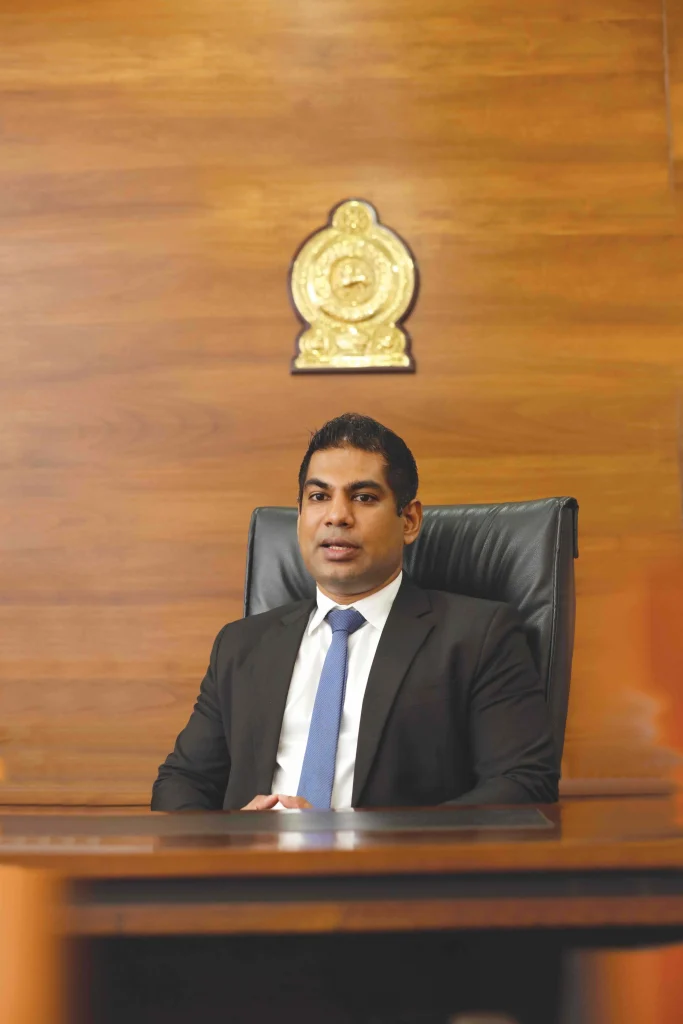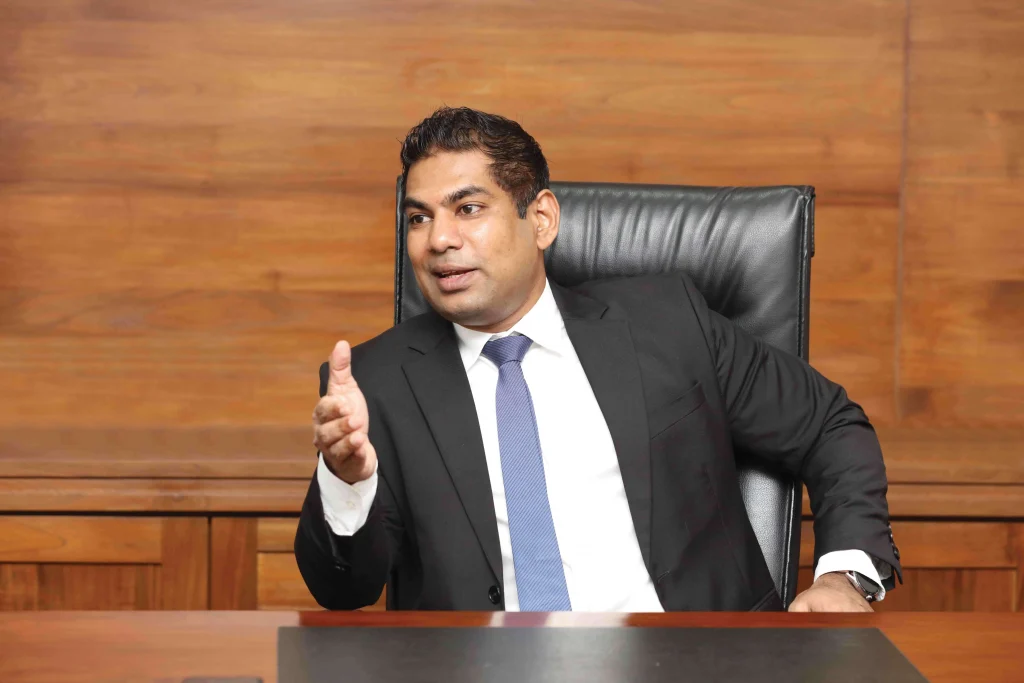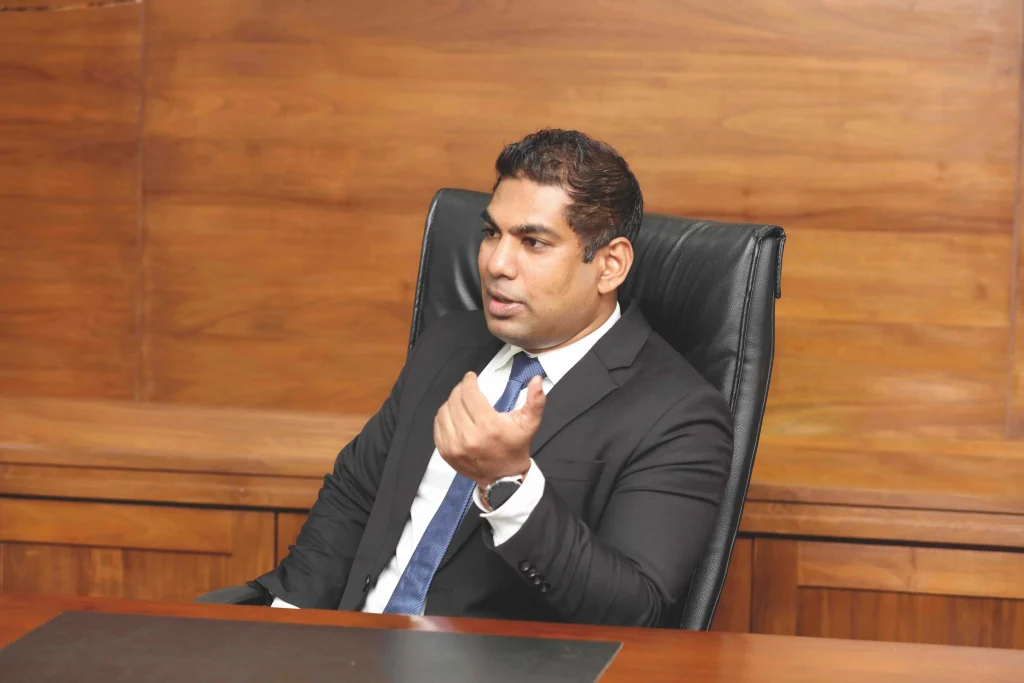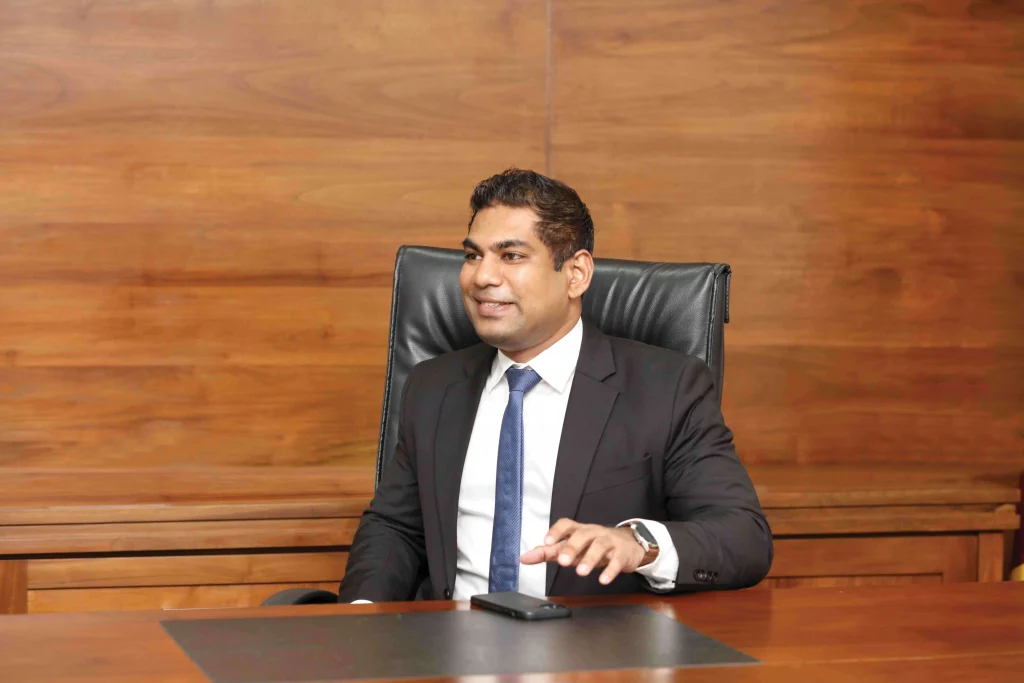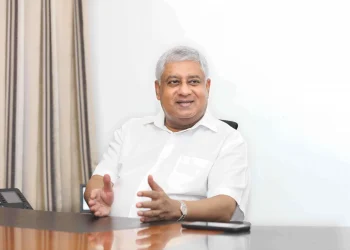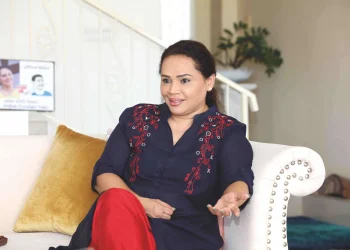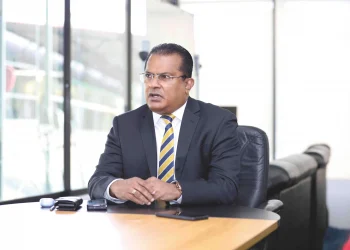Words: Jennifer Paldano Goonewardane.
The tariffs are here to stay, says Minister of Power and Energy, Kanchana Wijesekera. Admired for his competence and dedication to resolving the fuel and electricity crises, he has risen the ranks fast to take up a strong cabinet portfolio. Minister Wijesekera says there’s much work to be done, such as restructuring state-owned institutions like the CEB and the CPC to make them sustainable and profitable. A proponent of renewable energy, which should have been CEB’s game plan years ago when the telltale signs of an energy crisis were looming, minister Wijesekera is pushing for policy reform in the power and energy sector. At the same time, the time is rife for change. The success of the QR code-based National Fuel Pass is a feather in his cap. He’s calling for patience to weather the storm, which he envisages will ease in another four years. Until such time he is pushing for a transformation that will see a competitive environment in which multiple players with the CEB and CPC will do business to provide an efficient service to the consumers. Straight talking and unobtrusive, minister Wijesekera is determined to do the job professionally and fittingly, which he believes he could with the support of the Government and the Opposition parties. Admired and appreciated for taking up a disparaged portfolio at a time when others would have shuddered even to touch it, the Minister said that the country is still on a potentially eruptive volcano which the Government is trying to manage from exploding. Taking each day as his last day on the job, minister Wijesekera wants to do his best to see the transformation that the country, so desires become a reality.
Words: Jennifer Paldano Goonewardane.
Photography: Sujith Heenatigala and Dinesh Fernando.
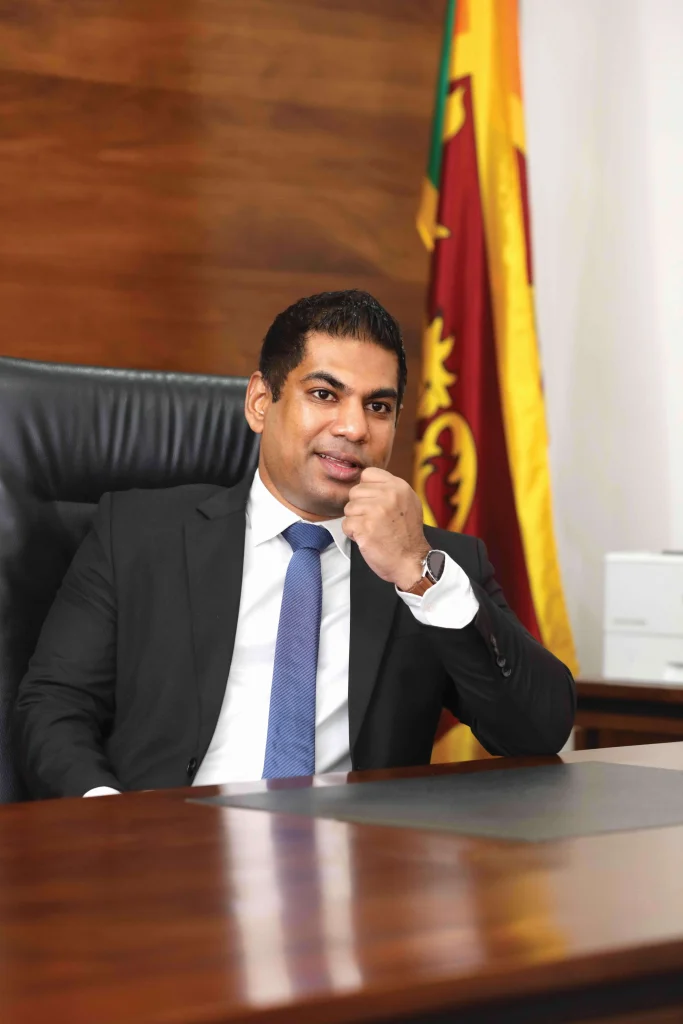
The talk these days is the electricity tariff hike. You have stated that low-income households will receive a new tariff scheme. Can you tell how you hope to achieve it and what measures you intend to take to soften the impact of the tariff hike on the tourism industry and appease religious opposition to the tariff hike? And can you tell us how the tariff hike will fulfill the revenue requirements of the CEB?
Tariff changes were necessary; we should have done them some time ago. The current tariff on electricity is the first electricity tariff revision since 2014. The last time we had a tariff increase was in 2013, while in 2014, there was a 25 percent decrease in electricity tariff with the commissioning of the Lakvijaya power plant in Norocholai. Meanwhile, there have been numerous requests since 2014 from the CEB and the PUCSL for a price revision. I would say that the tariff revision was overdue for eight years.
The cost of power generation in the last eight years has increased considerably, especially considering the cost from January to August 2022. The difference in numbers is massive. We generate nearly 1300 megawatts of electricity through hydropower, and the 1500 megawatts requirement is a mix of renewable energy and fossil fuels. The cost of a kilogram of coal which was 24 rupees, has increased to 114 rupees a kilogram between 1 January 2022 and 1 August 2022. Diesel price has gone up from 192 rupees to 430 rupees per liter. The price of furnace oil has also increased from less than 200 rupees to 419 rupees. The average generation cost is between 48 and 55 rupees per unit. People were paying a significantly lower rate than the generation cost.
I would say that every segment has been receiving a subsidy over the last eight years. Some sectors received significantly larger subsidies than others, especially the religious institutions that enjoyed a significant subsidy on electricity than any of the five sectors considered electricity tariff sectors. Between 48 and 55 rupees, the generation cost has increased CEB’s annual cost by about 850 billion. However, the collection was less than 300 billion rupees creating a gap of 500 billion rupees, which the CEB requested to be covered but did not receive. The PUCSL granted 200 billion rupees to the existing 300 billion rupees collection, bringing the recovery to around 500 billion rupees. In the meantime, we are examining ways of reducing the generation cost through restructuring and renewable energy development plans.
We, however, have not discussed revising the tariff rates. Currently, the CEB and the Ministry of Power and Energy believe there should be a further increase in the tariff. Giving subsidies is not something that we have discussed. Of course, suppose the Treasury or the Ministry of Finance decides to grant assistance by offering the shortfall to the CEB. In that case, we can consider providing relief to specific sectors like low-income households, religious institutes, or other sectors. Unless there is an arrangement to cover the loss of subsidized electricity, there is no possibility of granting further subsidies because today, low-income households and low-volume users receive subsidies. In contrast, high-volume users are charged more but still much lower than average.
All industries have made representations to us and voiced their concerns. However, we believe there is no possibility of granting subsidies to each sector unless the line ministries give that subsidy to the CEB or the Ministry of Finance. If we don’t collect the income generated through the tariff, we will be unable to procure coal, diesel, and furnace oil. As of now, the CEB is running at a massive loss. Suppliers of renewable energy have not received money for the last ten months. The private companies we purchased power from have not received their dues in months. The CEB owes nearly 80 billion rupees to the CPC. Payment obligations of the CEB are close to 670 billion rupees, requiring it to finance outstanding loans and the due obligations.
The PUCSL has warned that the current coal stocks are only sufficient until October and that failing to procure new supplies would plunge the country into longer power cuts again. What solution are you planning to mitigate this outcome when people pay a high tariff?
When I took office, the power cuts ranged from four and a half hours to six hours a day. Today, we have managed to reduce the number of daily power cuts to less than three hours a day. Fortunately, with the recent heavy rainfall, we have been able to provide redress to the consumers. Sometimes in the event of heavy rain, we have to opt not to cut power because the mini hydro and some of the reservoirs overfill, and we cannot store the free-flowing water and manage the daily power cuts. And that’s why amid heavy rainfall, although we had announced the daily power cut schedules for the different zones on most days, we did not carry forth the declared schedules in their entirety.
Today, we are again in a situation where we have no rain. The reservoirs are not functioning to their total capacity. We have to consider the prospect of future power generation. The decision rests between the option of six to eight hours of daily power cuts. Or we manage by continuing the routine of two to three hours of daily power cuts until we are stable with the plans for renewable energy. There may be other alternative ways of generating power at a lower cost.
In terms of coal, I would not say that the scenario announced by the PUCSL doesn’t stem from our inability to procure coal. We did the work surrounding its procurement on time. The Lanka Coal Company is responsible for the work surrounding coal procurement. The tender to procure coal was published on July 21, 2022 and closed on 10 August, and two companies bid for the tender. Usually, coal procurement is not an international open tender process. It’s a process available only to registered suppliers who have done so in the past in Sri Lanka and abroad and hence have experience supplying coal. There are 15 suppliers registered with the Lanka Coal Company, and although they all received notice, only two companies bid on the tender. One of the companies that bid could not fulfill all of the requirements, so the other company was awarded the contract. However, after the awarding, other companies were making unsolicited proposals. Political elements and civil society movements created a false or misleading narrative about the coal procurement process leading to a court battle. Once people took the issue to court, the supplier awarded to procure the coal was reluctant to proceed as they were unsure of the future.
They were procuring coal on a six-month credit basis. Every shipment would receive a six-month credit period with zero interest which was very important with the country’s financial situation. That was one of the guidelines provided by the Central Bank ahead of the procurement process to get suppliers who could provide coal on credit for at least 90 days. The forex situation, the declining rupee, and the downgraded bank ratings were some of the concerns of the Central Bank. In this milieu, the selected supplier has communicated that they will not perform on the award due to the financial risk involved with the issue being taken to court unless there is a legal guarantee and a much larger guarantee from the Central Bank on the payment method. We had to communicate their stand to the Cabinet, and now we have to call for new bidding.
There is a risk of running out of coal by October. We have a contingency plan for such an inevitability, although any contingency plan will work based on the availability of foreign exchange from the Central Bank and the banking system. That is a challenge. We have 19 cargoes of coal we procured at the last tender in 2021, which will be advanced to us to fulfill our current requirements. However, we will not receive credit on them, paying in full on arrival or before loading. So, we will be calling for fresh tenders. We hope it will attract new companies as it’s an open tender allowing foreign companies to bid this time. We are looking at companies that have dealt in this business and those companies and individuals who claim to have a repertoire of better options, such as competitive rates, so that we get the best deal to procure the required coal for the country. We invite individuals, companies, and even political parties that have communicated to the public that there are other options to bid on the new tender process so that we will not have to go for eight and nine hours of power cuts. I hope we will not have to go for such long hours of power outages. We are trying to manage the envisaged future scenario by maintaining daily power cuts at two and a half to three hours so that we will not have to go in for long hours of daily power cuts.
There is a global emphasis on accelerating the shift to cleaner energy sources while departing from fossil fuels, especially coal plants. How much can Sri Lanka scale and speed up this transition? Where has the CEB failed when a national audit presented in parliament in February found that the CEB had been unable to prioritize renewable energy?
We have close to 4300 megawatts of commissioned power generation, of which hydropower generates only 1300 megawatts, while the country generates 600 megawatts from rooftop solar power, and nearly 200 megawatts are from wind power. Probably one-third of electricity is generated from the Norocholai Coal power plant, while 1200 megawatts are generated through power plants using diesel and furnace oil. Maybe a little over one-third is generated through fossil fuel.
I think the CEB has failed not only in prioritizing renewable energy. It has failed with the power generation plan itself. The CEB is the authority calling the shots on the country’s energy plan. While they can blame every government that has come and gone every five years, the CEB has remained static for a long time. The engineers are the same. The general manager’s appointment is by the internal team of CEB employees. They have failed to take up the challenge to offer a power generation plan for Sri Lanka and make proposals based on that plan to ensure the sector’s long-term sustainability. I have asked them to develop a power generation and transmission plan for the next 40 years, based on which we could plan for renewable energy and other power plants already commissioned in Sri Lanka. They are working on it right now.
I agree that specific renewable energy projects could have commenced some time ago on a priority basis. Because we failed to prioritize some of them some time ago, we are facing two challenges today. Today’s increased costs and purchasing costs are due to CEB’s failure to prioritize a take-off in renewable energy projects. In terms of transmission and grid capacity development, the CEB has developed them with their funds or generated the funds through loans. We should change that to allow investors the opportunity to invest in grid development to speed things rather than wait for the CEB plans to materialize. As the failure of the CEB is laid bare in the current crisis, including its failure to submit a time plan for renewable energy and implement them as a possible power crisis was looming, we see the importance of restructuring the CEB.
There was a plan in 2002 to restructure the CEB to separate the generation, transmission, and distribution aspects to ensure efficient management. That’s what we are hoping to do this time in restructuring the CEB so that everyone in those processes is responsible for the energy sector in Sri Lanka.
I don’t think there is overwhelming opposition to reform from within the CEB. Neither will everyone agree to reform. There’ll always be a small number of people who will oppose anything. But having spoken with the unions, stakeholders, and political parties, they all echo the necessity for CEB’s restructuring. The disagreements are on how we should do it. There aren’t many people opposed to reform. Around 10 percent of the workforce may not favor the proposed restructuring plans, but I think the majority desire change.
How do you plan to manage the strong lobbying strength of the CEB that has long stood against energy sector reforms? Or have successive ministers been the reason for the delay as they offer no political incentive?
I wouldn’t say that the reason for former ministers’ failure to promote renewable energy was a lack of political incentive but rather the lack of support they had to implement such projects. Every Minister associated with the CEB and the power sector has tried their best to develop the capacities. Unfortunately, the ministers’ obstacles in the past had been the powerful CEB Act that didn’t allow them to work freely to expedite certain matters such as government procurement and tendering processes and awarding grid capacity and transmission lines. I am afraid I have to disagree that the lack of incentives was a hurdle to implementing those projects. Every Minister before me has done some work. I believe the previous ministers had done most of the hard work. But I would say successive governments, opposition parties, and everyone represented in Parliament is responsible for our mess. I include myself because we had failed to look at the required reforms a few years ago. We should have prioritized policy and implementation. We have the opportunity in this crisis to do the right thing right now.
We are examining ways of reducing the generation cost through restructuring and renewable energy development plans.
While the need of the hour is to push for more renewable energy projects, would you agree, as pointed out by specialists, that the country’s situation doesn’t augur well as they require investment which is a challenge in the current circumstances? At the same time, are there gaps in technology and infrastructure?
Of course, there are gaps. I don’t think our transmission plan includes renewable energy projects that most investors plan to operate in Sri Lanka. There are different agencies responsible for promoting renewable energy projects in Sri Lanka. I would say that the biggest problem is the Sustainable Energy Authority and the CEB not working together. The Sustainable Energy Authority is the government entity entrusted with implementing renewable energy plans for Sri Lanka, the institution with the power to grant permission, provisional approval, and energy approval. But at the end of the day, all such approvals must be in tandem with CEB plans and its power purchasing model. I’ve witnessed that even when the Sustainable Energy Authority obtains the land and environmental clearances if the CEB decides that they cannot accommodate the project, the project stops. Therefore, these two institutions must work together, especially in implementing renewable energy projects.
Former President Gotabaya Rajapaksa planned to go for 70 percent renewable energy by 2030. Even with that plan, the CEB’s transmission and grid capacity development plan does not accommodate the 70 percent renewable energy plan drawn as government policy. And that’s why we need to focus on determining our potential and use that potential, adjust the objectives accordingly and fill the gaps along the way so that the CEB and the SEA can work together on renewable energy projects.
Do you think there is a disconnect in the working relationship between the PUCSL and the CEB regarding power outages?
The PUCSL mandate is to drive the policy for the energy sector in Sri Lanka. But I don’t think the PUCSL has ever made that its priority. Recently, we’ve seen the PUCSL getting involved in deciding the power cuts. Their mandate is to create a policy framework, so the country has an uninterrupted power supply and implements power projects better. I believe the PUCSL doesn’t get the right people. When one considers the background of the board of directors and even chairpersons, it’s evident that they haven’t had much experience in the energy sector. The PUCSL is an institution with the power to dictate the terms for the energy sector in Sri Lanka. So, the PUCSL requires change where experienced independent energy experts are appointed to take forward and transform our energy sector.
In that case, Minister, don’t you think politicization could be the issue with the PUCSL?
Absolutely. The PUCSL is an independent commission. I believe we should amend the PUCSL Act so that any chairperson appointed by a government, parliament, or anyone else should have prior qualifications for eligibility. We must gazette the required qualifications as well. I don’t think there is any such dictate requiring the chairperson or board members of the PUCSL to have a specific capability for eligibility. That is a must. While having an amalgamation of legal and commercial experience on the board is essential, having personnel with energy sector experience in the PUCSL is vital. It’s a straightforward process to appoint someone, but removing that someone from the PUCSL is difficult. Those assigned to the PUCSL should be made responsible to parliament. The politicization of state institutions is rampant. But even some of those politicized institutions have performed well when the correct individuals are on the job, which is true of the PUCSL as well, where even though it’s a political appointment if the right individual is appointed, it would’ve made an enormous difference.
In terms of transmission and grid capacity development, the CEB has developed them with their funds or generated the funds through loans. We should change that to allow investors the opportunity to invest in grid development to speed things rather than wait for the CEB plans to materialize.
Since you speak of change, can you be the changemaker in this situation?
Unfortunately, the PUCSL is not under the ministry’s control. It’s an appointment made by parliament with the consent of the president and the government. Coming from an economics background, I had no experience in the sector when I took office as the power and energy minister. I have some knowledge of the fisheries and plantation sector. The intention in appointing me was to help manage the situation at that point. I believe that there are capable, experienced, and knowledgeable individuals who can take up my portfolio. As a minister, I want to be the bridge between the Government and the power and energy ministry so that the policy matters needing implementation and gaps needing closure will take off with me as the middle person. Everything else should be in the hands of the experienced or the experts in the industry.
Many are hailing the national fuel pass system as a resounding success as it has eased fuel queues. You and your ministry have come in for praise for spearheading the initiative. Can you tell us about its implementation when there was no rational solution for months?
Former President Gotabaya Rajapaksa allowed me to take up this challenge. We discussed the QR fuel management system even before his resignation. When Gotabaya Rajapaksa was in power, Ranil Wickremesinghe, the current President, was the Prime Minister when we discussed introducing a technology-based fuel management system to manage our limited resources. We did test a few options before, such as issuing a token and restricting volumes. We tried and tested different ways to manage the limitations in fuel and forex. We even tried flooding the market with fuel in some urban regions to reduce the queues. But none of them worked.
Following a discussion with the Central Bank and the Finance Ministry, we had an idea of the amount of forex that the Central Bank could allocate to import fuel. With that allocation, we knew we had to cut down nearly 40 percent of our fuel requirement, which meant we had to slash 40 percent of the import volume. At that point, we decided to use technology to manage the process efficiently. We were not sure of its success and whether it would reduce fuel queues. I still don’t think the QR system is the ideal and complete solution to the situation. It’s not a solution to eliminate the lines, but where every individual gets a guaranteed weekly quota of fuel, which may not be their requirement but at least a volume that helps them manage their weekly needs.
The former and current presidents encouraged me as the Minister to implement the technology-based fuel management system. While it was just an idea to help manage the fuel distribution, we were able to bring the concept to fruition thanks to the efforts of the ICTA, Dialog, and Millennium IT, whose experts did the crucial work of coming up with the software. We only had an idea that we had to reduce our fuel requirement from 600 million to 400 million. At the same time, those organizations’ technical experts and software engineers handled everything else. At the same time, the volunteers from institutions such as the National Youth Services Council, the National Youth Corps, LIOC, and the CPC contributed to making this management system a reality.
The former and current presidents encouraged me as the Minister to implement the technology-based fuel management system. While it was just an idea to help manage the fuel distribution, we were able to bring the concept to fruition thanks to the efforts of the ICTA, Dialog, and Millennium IT, whose experts did the crucial work of coming up with the software.
Do you think there is a strong case for privatizing the CPC in the current scenario where it runs a debt of one billion US$?
There’s no question about the need to restructure all state-owned enterprises. It’s a must. I firmly believe that any organization doing business should not be with the government but rather competing with other companies. The best example of restructuring a state-owned enterprise is Sri Lanka Telecom, a wholly government-owned entity that was not performing as well as it should have been. However, a public-private partnership helped it grow, expand and compete with other brands. Likewise, the CPC should compete with the LIOC and other suppliers. That could make a way to recover some of the losses and fulfill some of its obligations. The CPC owes nearly one trillion rupees to the state banks and the Government. There are some receivables as well. Sri Lankan Airlines owes the CPC about 300 US$ and the CEB about 18 billion rupees. And that’s why I think even Sri Lankan Airlines and the CEB should be subject to a restructuring process. We should restructure the CPC to allow them to provide an uninterrupted quality service that the people will appreciate. There will be healthy competition when more suppliers flood the market, and we hope to get at least three suppliers to the Sri Lankan market and the CPC and the LIOC who can share the market. The CPC, the owner of the stock tanks and the pipelines, could be the service provider for the four suppliers, similar to CPC’s services to the LIOC. That would generate a separate business for the CPC. I think it’s important to restructure through public-private partnerships for specific businesses, and I’m hoping to introduce those reforms before the end of December 2022.
To resolve the acute fuel shortage, Sri Lanka has been canvassing foreign oil companies to import, distribute and sell petroleum products in Sri Lanka. Can you tell us how that’s progressing?
We published an advertisement a few months ago, receiving responses from many entities expressing interest. As of the closing date, 24 companies from different parts of the world have shown interest in establishing their businesses here. The main requirement is that the company be a reputed supplier capable of working with the principal suppliers or their refineries to import petroleum products on credit for at least six months. Even the LIOC still depends on the banking system for foreign exchange, while we rely on foreign exchange from the Central Bank and the banking system. Our priority is to fulfill our requirements in the short term, for which a company should be able to supply us with petroleum products on a six-month credit basis while selling their products here and investing that money in infrastructure development for future progress. That was our initial plan, so we are hoping that by the end of November, we will have two or three reputed fuel suppliers in town. Some companies have shown interest after the advertisement was closed. But we will prioritize the companies that showed interest in the initial ad. If we fail to identify suppliers that fulfill our requirements, then there’s the possibility of looking at others, such as giving priority to government-to-government suppliers.
What is the agreement’s progress with USA’s New Fortress Energy for LNG?
Although we signed the agreements, the project has not yet commenced. Certain areas require finalizing before the project takes off. New Fortress Energy has some concerns, while the CEB and the CPC have theirs. We are also cognizant of the MOUs we entered with different countries some time ago. As it stands, the LNG project will not take off soon. There have been discussions on the possibility of reviving the interest shown by New Fortress Energy to invest in the project. We may look at separating certain parts of the project. Maybe New Fortress Energy can bring in the investment while we could negotiate pipeline and supply, which are in the discussion process. We’re hoping to have some of our LNG power plants, which is a must while building new LNG plants is also in the pipeline, which we’re working on right now.
How do you plan as a Government to navigate the geopolitical shockwave of the Russia-Ukraine war exacerbating the country’s difficulties in the energy sector?
The Russia-Ukraine war massively impacted the energy sector in Sri Lanka and globally, causing a procurement nightmare for us. The sanctions imposed on Russia are affecting certain Russian companies, and as a result, insurance companies are sometimes reluctant to give insurance to supplies from Russia. Hence, we must go to middle companies or separate entities to procure specific products. Even with coal procurement, the Sri Lanka Lakvijaya power plant can operate with only coal from Russia, South Africa, Indonesia, and Australia. Russia offers the lowest value for coal among these countries. Even with crude oil, the availability is only from Russia. There is a public opinion that Sri Lanka should look into getting cheaper oil or crude oil from its Russian counterpart. However, unfortunately, the Russian government doesn’t do business in oil, a business handled by private companies that don’t accept credit lines and expect cash transfers on arrival or before loading.
Our limitations in forex and the banking facilities, the bank ratings, and the country rating, are compounded by the Russia-Ukraine war and have made the energy sector chaotic. However, we are working with some companies to achieve a win-win situation. It’s not easy with the sanctions applied to European banks. As they scrutinize our transactions, it takes days to clear a transaction. At the same time, insurance companies refuse to respond to provide cover for some of the oil tankers coming to Sri Lanka.
We have a renewable potential of about 80 gigawatts for wind power in Mannar with onshore and offshore capability. And that’s why we need to plan a policy to become energy independent.
What do you think about addressing some of the energy issues through robust regional consultation and collaboration in the power sector to harness the benefits of renewable energy opportunities unevenly available within the region?
We have been discussing expanding grid connectivity with India, and even with such connectivity, I don’t think we will be able to export all our potential. We have a renewable potential of about 80 gigawatts for wind power in Mannar with onshore and offshore capability. And that’s why we need to plan a policy to become energy independent. To become energy independent, we have to use our natural resources to convert them into hydrogen and look to be an export hub for green hydrogen and renewable energy. Those are in our long-term plans, which will take some time to implement. Those are not in our immediate implementation plan.
We could achieve grid connectivity in three to four years if we start now. Although we have renewable potential, we have to plan on storage because our requirements are not the full potential, so how we plan to store and export them involves many policy and legislative amendments. However, in the meantime, we’re laying the foundation to achieve energy independence in the next few months.
Your portfolio has provided you with excellent public visibility, and you have received a great deal of praise from the public for handling the fuel and power crisis. How do you manage all that heat as much as the compliments?
It’s always good to receive praise, but it’s also good to understand the reality because it could take a second or minute to change the entire outcome. We are still on a potentially eruptive volcano which we are trying to manage so that it doesn’t erupt. We’re still walking on thin ice. It’s not a comfortable situation we’re in, which has trained me not to get too carried away with the praises I receive as I know the challenges are massive, requiring more support and time to come out of them. There’s much work to be done.
So, serving in a demanding and dynamic portfolio, do you feel like being pushed up or dragged down?
People are supporting me in achieving the tasks of my job. Of course, people will be trying to prevent me from reaching the required objectives. The majority are supportive, while very few may have a different opinion. Here I’m referring to institutions like the CEB and SEA. Everyone in Government has been supportive, including the Opposition parties in Parliament and former ministers. Discussions with former ministers of power and energy have been encouraging, and they have been supportive. Even former ministers who no longer are in Parliament, like former Speaker Karu Jayasuriya and Ravi Karunanayake, who have led these institutions, have shared advice and given me valuable insights. Several officials who have been in these industries for a long time have been very supportive. I don’t think anyone in Parliament is opposing or trying to prevent me from reaching the targets for the country. Everyone in Parliament has been supportive. There are differences in political opinion, but everyone has supported getting the work done.
You have the public image of a hard-working minister. Our political culture is such that we have hardly had an enabling environment for people that want to work. There’s always a struggle for power to ensure they retain their
I accepted this portfolio at a time when no one else would have wanted it. When I received it, I was shocked as well, but then I thought if I were to think of my chances at re-election, then I’m never going to do the work that we need to do to get the power and energy sector out of its current morass and transform it. I take each day as my last day on the job while I try to do my best to see the transformation we all envisage become a reality. And I’m not thinking of the next election. If we look at the next election and do judgment calls, I don’t think we can do our job. I’m comfortable with the way I work. If people want to elect me again, they will do so based on my credentials as a minister and not on promises.
On that basis, I keep working, and I believe there are other individuals with potential who probably did not get the proper responsibilities at the right time. Fortunately for me, Gotabaya Rajapaksa and Ranil Wickremesinghe allowed me to work. I think many more of my colleagues in Parliament are capable, energetic, and with experience, and are open to new policies and transformation. Given the opportunity will work hard. In the past, one has to be a three or four-term member of parliament to secure a cabinet portfolio or a senior position in power and energy. Being a second-time member of Parliament and first-time cabinet minister, I got this ministry to navigate challenging times.
We must restructure so that we expunge the monopoly. I believe there should be a regulating arm, which is why we are proposing, as part of the restructuring plan, more commercially viable opportunities and business partnerships and individuals with the capability to enter.
The power and energy sector are a monopoly where private players hardly get a chance to operate, but why is it still happening with even the small-time players sometimes wanting to give up working in the sector?
That’s why we must restructure so that we expunge the monopoly. I believe there should be a regulating arm, which is why we are proposing, as part of the restructuring plan, more commercially viable opportunities and business partnerships and individuals with the capability to enter. Of course, it’s going to be a challenge to transform these institutions. However, I believe that once we break up the monopoly and begin working with the private sector, the state sector will also start working like the private sector, as achieved in telecommunications in Sri Lanka. Hopefully, I’ll get to see that transformation during my tenure.
How did you feel when former president Gotabaya Rajapaksa chose you to take up the power and energy portfolio when everyone else would have shuddered at the prospect because that alone contributed to the government’s downfall?
I think former president Gotabaya Rajapaksa identified certain young members in Parliament to pursue his plans, and he did so by creating state ministries with additional responsibilities. Even as state ministers, we were given subjects and criteria to perform. Working under two cabinet ministers, Dr. Ramesh Pathirana and Douglas Devananda, was a learning curve.
I received the responsibility for power and energy when the entire Cabinet resigned. Only three cabinet ministers represented finance, foreign affairs, and public administration for a few days. At the same time, many of us were state ministers, and the rest were parliamentarians. That’s when the former president asked a few of us to look into the situation at CPC and CEB to reduce the lines at least before the New Year in April before I took over the power and energy portfolio. We worked for several days on this exercise together as a group, and we reduced some of the lines in the few days we had worked in those institutions with a distribution plan around the fuel stocks received on the Indian credit line. We got an understanding of what was required. I believe those few days I worked as a state minister to help sort out a messy situation probably gave Gotabaya Rajapaksa the confidence that I could turn things around, and that’s why he gave me two different ministries with two different challenges. It was overwhelming at one point. But taking over the portfolio, I believed I could make a difference.
Were you under much pressure when you got the portfolio? Some would have even discouraged you from accepting it, given the challenges.
Not really. My office staff and supporters were concerned about the impact of the price hikes on my political career and whether I was doing the right thing. But someone had to do the job. Yes, there were concerns about me accepting such a challenging job, but not the pressure to resign.
You are one of the few ministers who have delegated responsibilities to the two young state ministers under you, which many others are yet to do. People admire you for that.
I received responsibilities when I was a state minister as well. I was under Dr. Ramesh Pathirana when I received my first state minister portfolio in tea sector development. He gave me the freedom to take on institutions, take on responsibilities and do my job. I only had to discuss policy matters to determine their appropriateness. I had the same freedom with the fisheries ministry, where Douglas Devananda gave me the freedom to do my job. I was the implementing arm in those two ministries. Hence, with two state ministers, my job has been made easy. When I had only one state minister, I requested another as it’s two different sectors. I know these two state ministers did an excellent job previously in their state ministerial positions.
Chanaka has worked in aviation and the BOI. Hence, he better understands working on renewable projects that came to the BOI. He has experience working with banks to restructure Sri Lankan Airlines, which was not easy in the first two years, with no income generation due to a lack of flights. That’s why I’ve given him the responsibility to run the CPC and the high-scale BOI projects, which we are pursuing in a big way. Indika started his political career in the Pradeshiya Sabha, gradually rising to the top and performing well as state minister by building 30,000 houses for low-income families. I’ve given him the responsibility of looking into the distribution of petroleum and renewable energy projects and the issues faced by low-income households and religious places due to the tariff hike. The state ministers have given me much relief that I can focus on restructuring and the policy work in the ministry.
You are not identified with a family, and people hardly know that you are Mahinda Wijesekera’s son. How does your father feel about your achievements?
I was first elected to the provincial council in 2009 because of my father. I would have never won without my father’s supporters’ backing. Unfortunately, I did not have the privilege of my father’s support when I embarked on my parliamentary career. Since my first victory in the provincial councils, I think I owe it to my father for what he had done in Matara and hence my election. However, since then, I have had to work hard for my victories to get to the provincial council a second time and my first and second entries to parliament. The majority didn’t know my background. When I was working in the fisheries sector, many people knew me because my father had also worked there. In contrast, power and energy are two different sectors with different expertise, which has given me a distinct identity. My father would be proud of where I am today, but he is not in a state to grasp what’s going on as he’s been bedridden for the last 13 years since the bomb explosion in 2009.
What is your message as the Minister of Power and Energy?
It’s going to be a tough time. There will be changes that the public may not wholly agree with. Initially, it will be a massive burden on the people. However, let’s go through this phase to restructure and focus more on weathering the difficult phase by sharing the responsibility and supporting the transformation. I believe that we will see positive results in another three to four years. We may even be able to reduce the burden of the high electricity tariff with a transition to renewable energy. I believe Sri Lankans work better in a crisis. When the tariff is high, people will explore alternative ways of doing things and switch to alternative energy sources. We need time to resolve any problem. Hence patience is crucial while we go through policy implementation the right way rather than opting for quick fixes.
